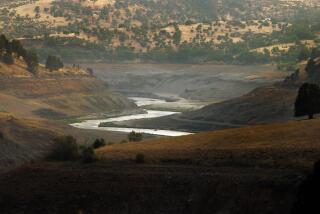Pioneering Israelis Parted the ‘Sea,’ but It Proved an Ecological Mistake : Mideast: Zionists drained a lake and wetlands 40 years ago, transforming a swamp into the Hula Valley. But few crops grew well here, and pollution followed.
- Share via
HULA VALLEY, Israel — Forty years ago, pioneers drained the Hula swamps in northern Israel to create farmland in a variant on the theme of making deserts bloom.
Today a new generation is re-flooding the land in an effort to repair the damage.
The transformation, costing around $20 million, is expected to return exhausted fields to their previous state as a marsh and recreational lake.
Back in the 1950s, the government believed the swamplands could become a cornucopia for Israel. As things turned out, the land was not fertile enough and draining the swamp destroyed a natural filter for Israel’s largest source of fresh water, the Sea of Galilee.
“At that time, the whole world, particularly the socialist nations, held the view that they had to change nature,” said Professor Francis Dov Por, a zoologist at Hebrew University of Jerusalem. “We know today that most of the projects didn’t work. It’s the same story all over the world.”
In the earlier project completed in 1957, workers drained a 5,000-acre lake and made another 25,000 acres of Hula Valley wetlands suitable for farming.
The very idea of turning mosquito-infested swamp into productive farmland captured the imagination of the young Zionist state. It led newsreels, stamps were printed to mark the occasion and campfire songs were composed to promote it.
As the outcome failed to live up to the dream, ecologists argued for years that the Hula should be re-flooded. Even after that argument won, for a long time there was no money to put nature back the way it was.
Such an attempt to undo human engineering of the environment signifies a big shift toward more environmental awareness among Israelis.
“The ecological issues are becoming more important in Israel,” said Eli Choter, chief nature warden for the district. “The reason (for the re-flooding project) is economic, but the solution is connected to the public opinion . . . that it was a mistake to drain the valley.”
Officials now say agronomists in the 1950s were wrong to expect the marshland to provide fertile farmland. In fact, soil quality has steadily declined.
A lack of vital trace elements, for one thing, means only certain crops can grow here, among them corn, melons and potatoes.
When the water was drained, peat remained--partly decayed, moisture-absorbing plant matter typically found in bogs and swamps. The peat sank, dropping more than 12 feet over the years.
When dried, peat can be used as fuel--and that turned out to be a disturbing trait for farmland. Periodically, large sections caught fire and smoldered, creating clouds of smoke and ash that periodically enveloped neighboring settlements for days at a time.
Far worse was the damage to Israel’s water supply.
Chanan Dimentman, an ecologist at Hebrew University, said that after the swamps were drained, seasonal flooding sent nourishing nitrates and phosphorus into the Sea of Galilee. Water quality worsened and the growth of algae exploded.
All this time, another fact of Israeli life was changing as well.
Farming settlements once held a political upper hand--as a mainstay of the national economy and, almost equally important, as a vehicle for transforming Jewish immigrants from the stereotypical bookish, sedentary and oppressed ghetto dwellers into robust people of the earth.
The farmers’ clout is gone.
“It certainly angers me,” Onn Rabinovitz of Kibbutz Kfar Giladi, a communal settlement built above the swamp, said of the re-flooding project.
Reaching with arms like tree trunks that were caked in mud, Rabinovitz pulled a clump of peanuts from the black Hula peat and, with thick, weathered fingers, cracked open a few. He has seen yields and profits drop and land fall fallow. But re-flooding farmland is anathema to him.
“The kibbutz farmers today are the best farmers around, but Israelis don’t want to work in agriculture anymore,” Rabinovitz said.
He contends that draining the Hula swamps was not a mistake and says he has developed a way to improve the soil by spraying manganese.
The new plan, financed by three state agencies, will re-flood 250 acres and turn another 1,250 acres into wetlands in this valley snuggled between the Naftali hills and the Golan Heights.
Flooding is scheduled to start when the rains begin this winter.
Lying on one of the world’s major migratory routes for birds, the shallow lake the project creates will include island sanctuaries where storks, eagles and vultures can rest and be observed.
The kibbutzim and moshavs, where farmers own their land and share equipment, will be compensated for the loss of farmland with government rights to build and manage a wildlife safari park. They also will receive concessions for boating, windsurfing and other recreational activities.
Dimentman said draining the swamp led to the extinction of the indigenous black-finned frog and the near extinction of many invertebrates and fish. He hopes that when the swamp returns, they will be fruitful and multiply.
More to Read
Sign up for Essential California
The most important California stories and recommendations in your inbox every morning.
You may occasionally receive promotional content from the Los Angeles Times.










